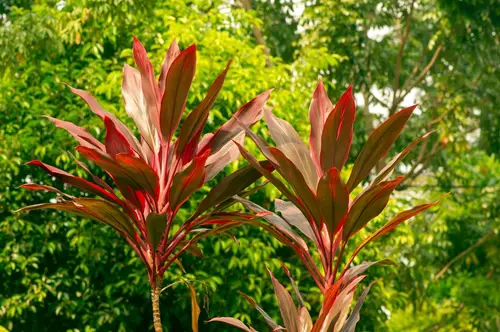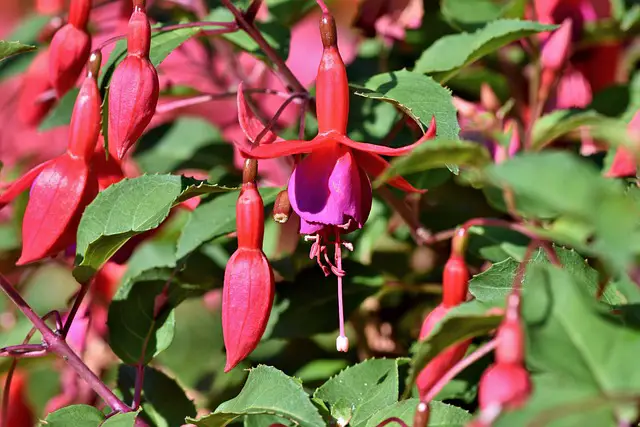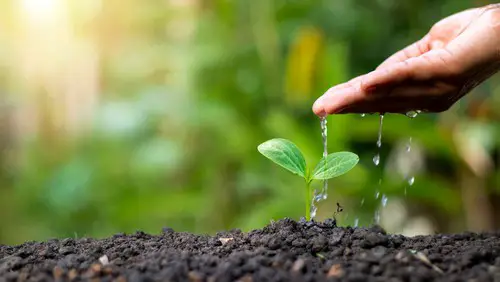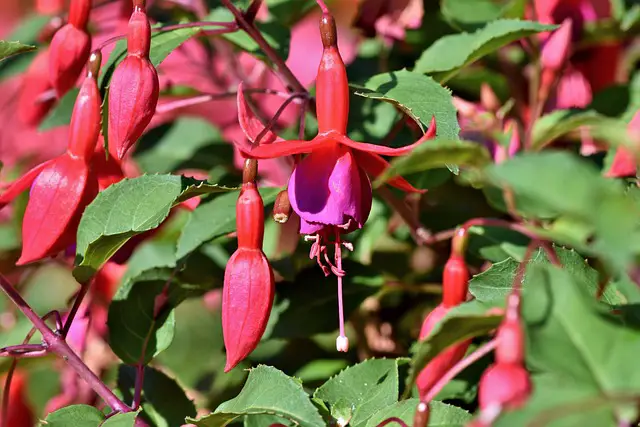Fuchsia plants are a favorite among gardeners for their vibrant, pendulous flowers that bloom in a range of colors. However, yellowing leaves can be a common problem for fuchsia plants, which can be concerning for those who want to keep their plants healthy and thriving.
There are several reasons behind Fuchsia Leaves Turning Yellow, and understanding these causes can help gardeners take the necessary steps to prevent and treat the issue.
One of the most common causes of yellowing fuchsia leaves is watering issues. Overwatering or underwatering can lead to yellow leaves, as the plant may not be getting enough or too much water to properly perform photosynthesis.
Additionally, soil and root problems, such as root rot or poor drainage, can also contribute to yellowing leaves. Environmental factors, such as too much sun or high temperatures, can also cause damage to the plant and lead to yellowing leaves.
Key Takeaways
- Yellowing leaves on fuchsia plants can be caused by several factors, including watering issues, soil and root problems, environmental factors, nutrient deficiencies, and disease and pest issues.
- Proper watering and soil care can help prevent yellowing leaves on fuchsia plants.
- Identifying symptoms and solutions early on can help prevent further damage to fuchsia plants and keep them healthy.
Other top posts in this category:
- Why Are My Eggplant Leaves Turning Yellow?
- Why Are My Cyclamen Leaves Turning Yellow?
- Why Are My Cantaloupe Leaves Turning Yellow?
Understanding Fuchsia Plants

Fuchsia plants are a popular choice for gardeners who are looking for a flowering plant that is both beautiful and easy to care for. These plants are native to South America and are known for their hardy nature. They are also known for their bicolor flowers, which come in a wide range of colors, including pink, purple, red, and white.
Fuchsia plants are classified as shrubs and can grow up to six feet tall. They are a popular choice for gardeners who are looking for a plant that can provide both color and structure to their garden. Fuchsia plants are also popular with hummingbirds, which are attracted to their bright colors and sweet nectar.
One of the reasons why fuchsia plants are so popular is because they are relatively easy to care for. They prefer well-draining soil and should be watered regularly. They also require regular fertilization to ensure that they are getting the nutrients that they need to thrive.
Fuchsia plants are also known for their hardiness. They can tolerate a wide range of temperatures and can even survive frost. This makes them a popular choice for gardeners who live in areas with harsh winters.
Fuchsia Leaves Turning Yellow – 4 Common Problems
Yellow leaves are a common problem that Fuchsia growers face. Here are some of the most common causes of yellowing Fuchsia leaves:
1. Improper Watering
Improper watering is the most common cause of yellowing Fuchsia leaves. Overwatering or underwatering can cause the leaves to turn yellow and eventually fall off. The roots of the plant need to be kept moist but not waterlogged.
If the soil is too dry, the leaves will wilt and turn yellow. If the soil is too wet, the leaves will turn yellow and fall off. It is important to water the plant regularly and to make sure the soil is well-drained.
2. Nutrient Deficiencies
Yellowing leaves can also be a sign of nutrient deficiencies. Fuchsia plants need nitrogen, potassium, magnesium, and iron to grow properly. If the plant is not getting enough of these nutrients, the leaves will turn yellow and eventually fall off.
A soil test can help determine if the plant is lacking in any of these nutrients. If a deficiency is found, it can be corrected by adding the necessary nutrients to the soil.
3. Pests and Diseases

Pests and diseases can also cause yellowing Fuchsia leaves. Spider mites, whiteflies, and aphids are common pests that can infest Fuchsia plants. These pests feed on the leaves, causing them to turn yellow and eventually fall off.
Fungal diseases such as rust and powdery mildew can also cause yellowing leaves. These diseases can be treated with fungicides and insecticides.
4. Environmental Factors
Environmental factors such as too much sun or too little light can also cause yellowing Fuchsia leaves. Fuchsia plants need bright but indirect light to grow properly. If the plant is getting too much sun, the leaves will turn yellow and eventually fall off.
If the plant is not getting enough light, the leaves will turn yellow and shrivel up. It is important to find the right balance of light for the plant to thrive.
Watering Issues
Improper watering is one of the most common reasons for yellowing fuchsia leaves. Both overwatering and underwatering can cause the leaves to turn yellow, so it’s essential to find the right balance.
Fuchsia plants require moist soil, but they don’t like to sit in water. Poor drainage can cause moisture stress, which can lead to yellowing leaves. It’s crucial to ensure that the soil has adequate drainage to prevent water from accumulating around the roots.
Overwatering can also lead to yellowing leaves. When the roots are saturated with water, they can’t absorb oxygen, which can cause root rot and other fungal diseases. If the soil is too wet, the plant may show signs of wilting, and the leaves may turn yellow.
On the other hand, underwatering can also cause yellowing leaves. When the plant doesn’t get enough water, it can’t perform photosynthesis, which can cause the leaves to lose their healthy green color. The soil should be kept consistently moist, but not waterlogged.
To prevent watering issues, it’s essential to water the plant correctly. The best way to water fuchsia plants is to water them deeply and then allow the soil to dry out slightly before watering again. This will ensure that the roots have access to water without becoming waterlogged.
Soil and Root Problems
Yellowing fuchsia leaves can be caused by soil and root problems. Fuchsia plants require well-draining soil to thrive. If the soil is too compact or waterlogged, the roots can become damaged, leading to yellowing leaves.
Root rot is a common problem that can affect fuchsia plants when they are grown in soil that is too wet. This fungal disease can cause the roots to rot, making it difficult for the plant to absorb nutrients and water.
As a result, the leaves may turn yellow and drop off. To prevent root rot, it is important to ensure that the soil is well-draining and not waterlogged.
Another soil-related issue that can cause yellowing leaves is hard water. Fuchsia plants are sensitive to the minerals found in hard water, such as calcium and magnesium.
Over time, these minerals can build up in the soil and cause nutrient imbalances, leading to yellowing leaves. To prevent this, it is recommended to use rainwater or distilled water when watering fuchsia plants.
In addition to soil problems, root problems can also cause yellowing leaves. When the roots are damaged or diseased, they may not be able to absorb nutrients and water effectively, which can result in yellowing leaves. It is important to inspect the roots of fuchsia plants regularly to ensure that they are healthy and free from damage.
Environmental Factors

Environmental factors can play a significant role in causing yellowing leaves on fuchsia plants. Exposure to direct sunlight can cause leaves to yellow and drop off, especially during hot summer months.
In particular, fuchsia plants are sensitive to too much sun, and high temperatures can cause stress. If the plant is in a location that receives too much direct sunlight, it may need to be moved to a spot with partial shade.
In addition to sunlight and high temperatures, wind can also cause stress to fuchsia plants. Strong winds can dry out the soil quickly, causing the plant to wilt and the leaves to turn yellow. Make sure to water the plant more frequently during windy periods.
Changes in temperature can also cause yellowing leaves. If the plant is exposed to sudden temperature changes, such as being moved from indoors to outdoors or vice versa, it may experience stress and yellowing leaves. To avoid this, gradually acclimate the plant to the new environment over a few days.
Lastly, humidity levels can also impact the health of fuchsia plants. If the air is too dry, the leaves may start to yellow and drop off. Consider misting the plant or placing a tray of water nearby to increase humidity levels.
Nutrient Deficiencies
Fuchsia plants require specific nutrients to grow and thrive. If a fuchsia plant is not receiving enough of these nutrients, its leaves can start to yellow. Here are some common nutrient deficiencies that can cause yellowing of fuchsia leaves:
Nitrogen Deficiency
One of the most common nutrient deficiencies that can cause yellowing of fuchsia leaves is nitrogen deficiency. Nitrogen is an essential nutrient that plants need to grow healthy foliage.
When a fuchsia plant is lacking in nitrogen, its older, inner leaves turn yellow first. As the deficiency progresses, yellowing moves outward, eventually reaching young leaves.
Lack of Magnesium
Another possible reason a fuchsia has yellow leaves is a lack of magnesium, especially if the plant has been in the same pot for several years. Its magnesium supplies may have been sapped dry.
You can add magnesium back to the soil by applying Epsom salts dissolved in water. Magnesium deficiency shows up as yellowing between the veins of older leaves.
Other Nutrient Deficiencies

Fuchsia plants also require other nutrients such as phosphorus and potassium to grow and thrive. If a fuchsia plant is not receiving enough of these nutrients, its leaves can start to yellow.
For instance, leaf edges turning bright yellow but inside leaf remaining green are signs of potassium insufficiency. Phosphorus deficiency shows up as a general yellowing.
It is important to note that over-fertilizing can also cause yellowing of fuchsia leaves. Always follow the instructions on the fertilizer package and do not exceed the recommended dosage.
Disease and Pest Issues
Yellowing leaves on fuchsia plants may be a sign of disease or pest issues. Fuchsia rust is a common disease that appears as yellow spores on the bottom and sometimes on both sides of the leaves.
Verticillium wilt is another fungal disease that causes the foliage of fuchsias to turn yellow, pale green, or brown, often beginning on one side of the plant. As the disease progresses, leaves shrivel and drop off the plant. This fungal disease is often deadly.
To prevent and control fuchsia rust, it is recommended to remove and destroy infected leaves and prune the plant to improve air circulation. Fungicides containing trifloxystrobin can also be used to control the disease.
For verticillium wilt, there is no cure, and infected plants should be removed and destroyed to prevent the disease from spreading.
In addition to diseases, pests can also cause yellowing leaves on fuchsia plants. Aphids, whiteflies, and thrips are common pests that can cause yellowing leaves on fuchsias. These pests feed on the sap of the plant, which can cause leaves to turn yellow and eventually fall off.
To control these pests, it is recommended to use insecticidal soap or neem oil. Regularly inspecting the plant for signs of pests and promptly treating any infestations can help prevent yellowing leaves on fuchsia plants.
Botrytis blight is another fungal disease that can cause yellowing leaves on fuchsia plants. This disease is caused by the fungus Botrytis cinerea and can cause grayish-brown spots on leaves, stems, and flowers.
Infected leaves may also turn yellow and eventually fall off. To prevent and control Botrytis blight, it is recommended to remove and destroy infected plant parts, improve air circulation, and use fungicides containing trifloxystrobin.
Other Causes
While inadequate watering is the most common cause of yellowing fuchsia leaves, there are other factors that can contribute to this issue. Understanding these other causes can help fuchsia plant owners take the necessary steps to revive their plants.
1. Natural Process

In some cases, yellowing leaves may be a natural process of the plant’s growth cycle. Fuchsia plants may shed their older leaves in the fall, which can cause yellowing. This is a natural process and is not a cause for concern.
2. Transplant Shock
Transplant shock can also cause yellowing leaves in fuchsia plants. When a fuchsia plant is transplanted, it can experience stress and shock, which can affect its ability to absorb nutrients and water. This can result in yellowing leaves. To prevent transplant shock, it is important to ensure that the plant is well-watered before and after transplanting.
3. Sunburn
Fuchsia plants can also experience sunburn, which can cause yellowing leaves. This occurs when the plant is exposed to too much direct sunlight. To prevent sunburn, it is important to ensure that the plant is placed in a location with partial shade.
Air Circulation
Poor air circulation can also cause yellowing leaves in fuchsia plants. When the plant does not receive enough oxygen, it can affect its ability to perform photosynthesis, which can lead to yellowing leaves. To improve air circulation, it is important to ensure that the plant is not overcrowded and has enough space to grow.
4. Other Factors
Other factors that can contribute to yellowing fuchsia leaves include pests and diseases. It is important to regularly inspect fuchsia plants for signs of pests and diseases, and to take the necessary steps to prevent and treat these issues.
Care and Prevention Tips
To prevent yellowing of fuchsia leaves, it is important to provide proper care to the plant. Here are some tips to keep in mind:
- Watering: Fuchsias require regular watering, but overwatering can lead to root rot and under watering can cause the leaves to turn yellow. Water the plant when the top inch of soil is dry to the touch. Avoid getting water on the leaves, as this can lead to fungal diseases.
- Light and Temperature: Fuchsias prefer partial shade to full sun, but too much sun can cause the leaves to yellow. They also prefer cooler temperatures, so avoid placing them in direct sunlight during the hottest parts of the day.
- Fertilizing: Fuchsias benefit from regular fertilization during the growing season. Use a balanced fertilizer every two weeks to promote healthy growth and blooming.
- Pruning: Regular pruning can help keep the plant healthy and prevent yellowing leaves. Remove any dead, damaged, or diseased leaves and branches, and pinch back the tips of the stems to encourage bushier growth.
- Pest Control: Fuchsias are susceptible to a variety of pests, including aphids, mites, and whiteflies. Regularly inspect the plant for signs of infestation, and treat with neem oil or insecticidal soap if necessary.
- Disease Control: Fungal diseases can cause yellowing of fuchsia leaves. To prevent these diseases, avoid overhead watering and provide good air circulation around the plant. If you notice any signs of disease, such as yellow or brown spots on the leaves, remove and destroy the affected leaves and treat the plant with a fungicide.
With proper care and prevention, fuchsia plants can thrive and bloom all summer long in hanging baskets or containers. Regular watering, fertilizing, pruning, pest and disease control, and providing the right amount of light and temperature are key to preventing yellowing of fuchsia leaves.
Identifying Symptoms and Solutions
Fuchsia plants are known for their vibrant and colorful blooms, but sometimes their leaves can turn yellow, which can be a sign of an underlying problem. Here are some symptoms to look out for and solutions to help revive your plant.
Symptoms

One of the most common symptoms of a fuchsia plant with yellowing leaves is wilting or drooping. This can be a sign of over or under watering. If the soil is too dry, the plant will wilt, and if it’s too wet, the roots can rot, leading to yellowing leaves.
Another symptom to look out for is brown spots or blotches on the upper leaf surface. This can be a sign of a fungal or bacterial infection, which can spread quickly and cause the plant to die. Orange pustules on the underside of the leaves can also be a sign of a fungal infection.
Solutions
To revive your fuchsia plant, it’s important to identify the underlying problem and take the appropriate steps to fix it. Here are some solutions to common problems:
- Overwatering: If the soil is too wet, stop watering the plant until the top inch of soil feels dry to the touch. You may also need to repot the plant in fresh, well-draining soil to prevent root rot.
- Underwatering: If the soil is too dry, water the plant deeply until water drains out of the bottom of the pot. Make sure to water the plant consistently to prevent it from drying out again.
- Nutrient deficiencies: Yellowing leaves can be a sign of nutrient deficiencies, such as nitrogen, potassium, magnesium, and iron. Adding a general-purpose fertilizer can help fix this problem.
- Fungal or bacterial infections: If your fuchsia plant has a fungal or bacterial infection, it’s important to remove any infected leaves and treat the plant with a fungicide or bactericide.
- Branches: If the branches of your fuchsia plant are also turning yellow, it may be a sign of a more serious problem, such as a root disease or pest infestation. In this case, it’s best to consult a professional for advice.
Frequently Asked Questions
What causes yellow leaves on fuchsia plants?
Yellowing leaves on fuchsia plants can be caused by a variety of factors, including nutrient deficiencies, pests, diseases, and environmental stress. One common cause is a lack of nitrogen, which is an essential nutrient for plant growth.
Other possible causes include overwatering, underwatering, and exposure to extreme temperatures or direct sunlight.
How can I treat fuchsia rust?
Fuchsia rust is a fungal disease that can cause yellowing leaves, as well as brown spots and powdery growth on the undersides of leaves.
To treat fuchsia rust, it is important to remove and dispose of any infected leaves or branches immediately. Fungicides can also be used to prevent the spread of the disease.
Why are fuchsia leaves turning brown and yellow?
Fuchsia leaves may turn brown and yellow due to a variety of factors, including fungal infections, pests, nutrient deficiencies, and environmental stress. Overwatering or underwatering can also cause leaves to turn brown and yellow.
What are the signs of an underwatered fuchsia plant?
Signs of an underwatered fuchsia plant include wilted leaves, dry soil, and yellowing leaves that may also be crispy or brittle to the touch. If the soil is dry up to an inch deep, the plant needs watering.
How do I fix yellow leaves on my fuchsia?
To fix yellow leaves on a fuchsia plant, it is important to identify and address the underlying cause. If the cause is a nutrient deficiency, fertilizing the plant may help.
If the cause is overwatering or underwatering, adjusting the watering schedule may be necessary. Removing infected leaves or branches and using fungicides can also help treat fungal infections.
What is the best watering schedule for fuchsia plants?
Fuchsia plants prefer moist soil but can be susceptible to root rot if overwatered. It is best to water fuchsia plants when the soil is dry up to an inch deep.
The frequency of watering will depend on the environment and growing conditions, but generally, fuchsia plants should be watered once or twice a week during the growing season and less frequently during the dormant season.


